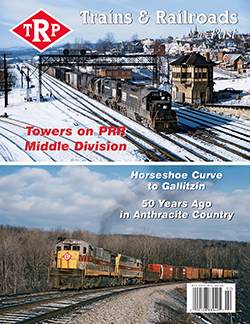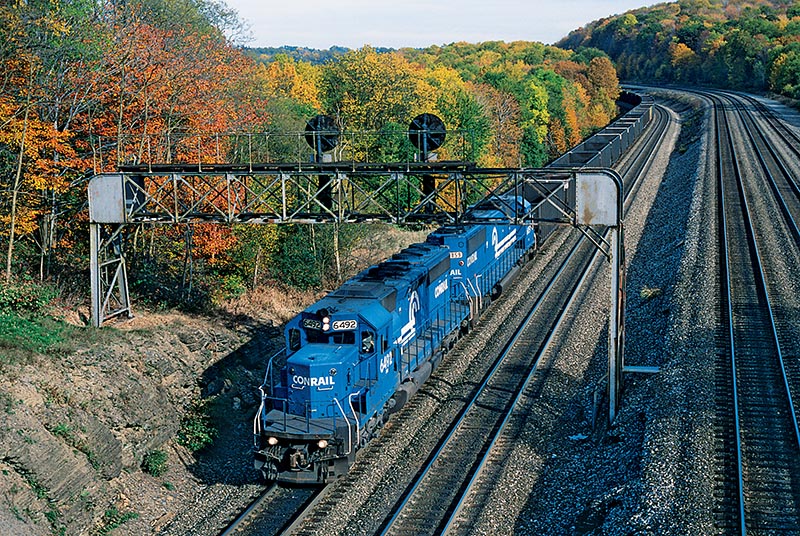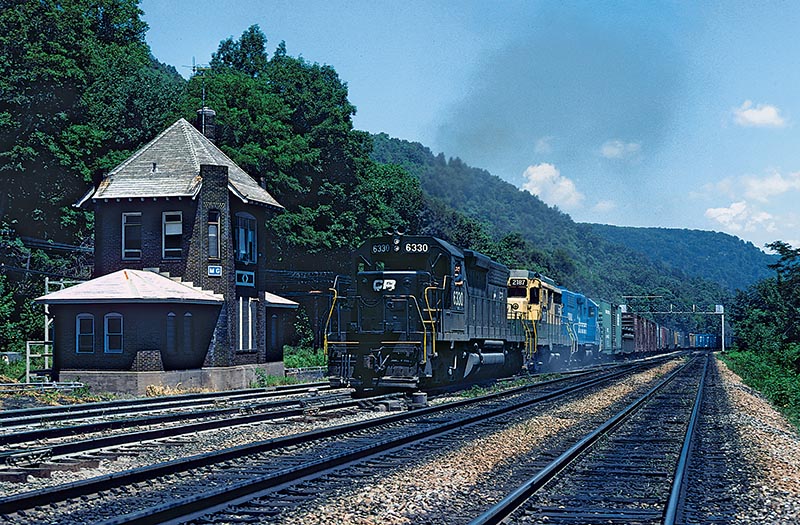 by Carl Graves/photos as noted
by Carl Graves/photos as noted
My first visit to Pennsylvania’s Horseshoe Curve was in my imagination, courtesy of Stephen Header’s 1944 book, The Long Trains Roll. A sixth grader in Oklahoma, I was hooked when I opened the cover and saw a two-page drawing of multiple steam-powered freight and passenger trains at various locations on the curve, surrounded by scenic Appalachian hills and ridges. I quickly identified with the main character, 17-year-old Randy, who lived on a farm near the curve and was working on a section gang that summer. His father was a Pennsylvania Railroad helper locomotive engineer, while his older sister did office work in the huge Gaptown car shops, next to which was a hump yard. The text had railroad jargon like “hogger” and “Big O.”
On his way to work, Randy walked along the curve. “Spread before him was the four-track main line of the railroad, climbing in a long loop to the crest of the divide, where Calico Gap cut its black notch against the sky. From where he stood there were four trains in sight.” Troop and passenger trains, freights loaded with ammunition, tanks, and other crucial supplies for the U.S. war effort passed through the area in a steady stream. He thought: “It would do some real damage if the Germans could block the high iron.” In this engaging book, he became suspicious of a new track worker named Burns, who, along with a shadowy figure named Fritz, turned out to be Nazi spies intent on sabotaging this crucial railroad link. With the aid of a friend and an FBI agent, Randy was able to thwart this German plot.
This tale was loosely based on an actual Nazi attempt in June 1942 to land operatives from submarines and use dynamite to blow up key wartime infrastructure. These included New York City’s Hell Gate Bridge, the Pennsy four-track main line and Allegheny tunnels at Gallitzin, as well as the Altoona car shops. Thanks in part to a German defector, this sabotage plan, called Operation Pastorius, did not happen. The FBI arrested the plotters, who were tried, convicted, and executed…

ABOVE: The fall colors are just about at peak on October 17, 1998, as a westbound train of empty hoppers approaches Cresson from the vantage point of the Pennsylvania State Route 53 overpass. The train is on No. 4 Track and has just started the downgrade trip on the West Slope. No. 3 track is next to the train, while Track 2 and Track 1, used for eastbound traffic, are at a higher elevation at right. To their right is the “Zero Track,” a later addition by PRR that added operational flexibility. Next to the Zero Track is an access road that replaced a siding that once provided a sixth track between MO Tower at Cresson and AR Tower at Gallitzin. —Photo by David P. Oroszi

ABOVE: A two-unit SD45 helper set is pushing on the rear of a westbound train on Track 3 going through Allegheny Tunnel in this view at the east portal from August of 1980. The ventilators have been removed from Gallitzin Tunnel at right, but the brick powerhouse and the rusting ventilators for Allegheny Tunnel are still in place, soon to be removed. The track diverging under the helper set is a connection to the New Portage Secondary Track to Hollidaysburg. The photographer is standing on the embankment for eastbound Track 1 and Track 2 (“The Slide”), at the point where the connecting track passed underneath the eastbound tracks. Those two tracks known as “The Slide” make reference to how steep the grade is here and the tremendous amount of effort and skill it takes for crews to keep trains from sliding uncontrollably down the hill. —Photo by Joseph A. Slanser, collection of David P. Oroszi

ABOVE: I didn’t take a photo of MG tower, so here’s a classic view from much earlier in Conrail’s tenure, as a former Penn Central (PRR) SD45 leads a ex-Reading GP30 and another Geep in full Conrail dress blue past the historic structure with a freight consisting mostly of empties heading back to western connections. MG Tower was not easy to reach, sitting at the end of a steep and winding unpaved road more than a mile from Sugar Run Road at the bottom of the valley. The operator at MG controlled a set of universal crossovers between all the main tracks. The tower was a later addition, built in 1944, replacing an earlier structure and interlocking (AG Tower) about a mile further to the west. The call letters MG stood for “Mid-Grade,” although the location between mileposts 243 and 244 was actually about two-thirds up the westbound grade. On June 26, 1977, a westbound train passes the tower with a three-unit power set typical of the early Conrail era. —photo by David P. Oroszi



